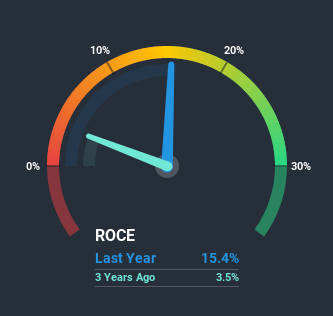Here’s What’s Happening With Returns At General Packer (TYO:6267)

If you're not sure where to start when looking for the next multi-bagger, there are a few key trends you should keep an eye out for. Typically, we'll want to notice a trend of growing return on capital employed (ROCE) and alongside that, an expanding base of capital employed. Ultimately, this demonstrates that it's a business that is reinvesting profits at increasing rates of return. So on that note, General Packer (TYO:6267) looks quite promising in regards to its trends of return on capital.
What is Return On Capital Employed (ROCE)?
For those who don't know, ROCE is a measure of a company's yearly pre-tax profit (its return), relative to the capital employed in the business. The formula for this calculation on General Packer is:
Return on Capital Employed = Earnings Before Interest and Tax (EBIT) ÷ (Total Assets - Current Liabilities)
0.15 = JP¥849m ÷ (JP¥8.7b - JP¥3.1b) (Based on the trailing twelve months to January 2021).
So, General Packer has an ROCE of 15%. On its own, that's a standard return, however it's much better than the 6.4% generated by the Machinery industry.
Check out our latest analysis for General Packer

Historical performance is a great place to start when researching a stock so above you can see the gauge for General Packer's ROCE against it's prior returns. If you want to delve into the historical earnings, revenue and cash flow of General Packer, check out these free graphs here.
What Does the ROCE Trend For General Packer Tell Us?
The trends we've noticed at General Packer are quite reassuring. The data shows that returns on capital have increased substantially over the last three years to 15%. The company is effectively making more money per dollar of capital used, and it's worth noting that the amount of capital has increased too, by 22%. So we're very much inspired by what we're seeing at General Packer thanks to its ability to profitably reinvest capital.
What We Can Learn From General Packer's ROCE
A company that is growing its returns on capital and can consistently reinvest in itself is a highly sought after trait, and that's what General Packer has. Since the stock has returned a solid 87% to shareholders over the last five years, it's fair to say investors are beginning to recognize these changes. Therefore, we think it would be worth your time to check if these trends are going to continue.
General Packer does have some risks though, and we've spotted 1 warning sign for General Packer that you might be interested in.
For those who like to invest in solid companies, check out this free list of companies with solid balance sheets and high returns on equity.
If you decide to trade General Packer, use the lowest-cost* platform that is rated #1 Overall by Barron’s, Interactive Brokers. Trade stocks, options, futures, forex, bonds and funds on 135 markets, all from a single integrated account. Promoted
New: Manage All Your Stock Portfolios in One Place
We've created the ultimate portfolio companion for stock investors, and it's free.
• Connect an unlimited number of Portfolios and see your total in one currency
• Be alerted to new Warning Signs or Risks via email or mobile
• Track the Fair Value of your stocks
This article by Simply Wall St is general in nature. It does not constitute a recommendation to buy or sell any stock, and does not take account of your objectives, or your financial situation. We aim to bring you long-term focused analysis driven by fundamental data. Note that our analysis may not factor in the latest price-sensitive company announcements or qualitative material. Simply Wall St has no position in any stocks mentioned.
*Interactive Brokers Rated Lowest Cost Broker by StockBrokers.com Annual Online Review 2020
Have feedback on this article? Concerned about the content? Get in touch with us directly. Alternatively, email editorial-team (at) simplywallst.com.
About TSE:6267
General Packer
Designs, manufactures, and sells various packaging machines and peripheral equipment in Japan and internationally.
Flawless balance sheet and good value.
Market Insights
Community Narratives



